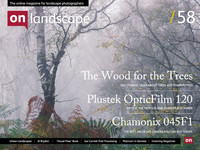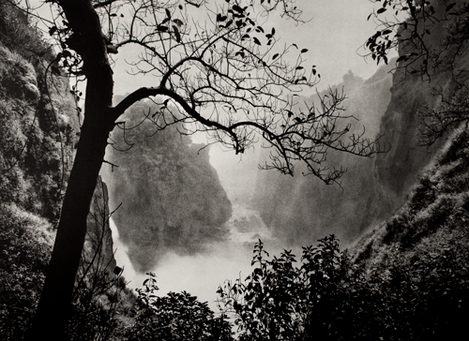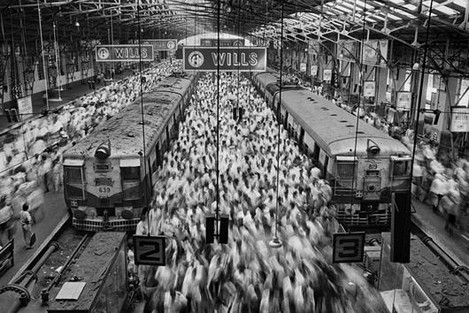A Look at Platinum vs Inkjet via Salgado's Genesis Project
We've already discussed Sebastio Salgado's Genesis exhibition, but this month also sees the release of 50 selected platinum prints also on display in London, at Phillips de Pury. As someone who prints with inkjet, silver and more recently alternate processes, including a recent start in platinum, I thought it would be an interesting exercise to view these exhibitions together on the same day. I have tried to approach it open minded, but realised the artisan in me couldn't help but want the platinum images to be 'better'.
So I joined the queue at the National History Museum before opening and went straight to the Genesis exhibition (another review here). This is a vast, epic exhibit, a real 'blockbuster' as I heard someone next to me remark. The images themselves focus on the natural world, encouraging us to reflect on our own lifestyles and our impact. Many images also feature indigenous peoples in their traditional dress. Salgado's inkjets are large and printed hard, very black and white yet managing to retain just enough highlight and shadow detail to make the image sing. This was no display of subtlety in the mid values, this was high impact printing. Most images work perfectly, but a few I found too 'overdone' to my taste, with a hint of an HDR type look. The inkjets themselves, are printed on a gloss paper so that the blacks are incredibly dense.
It is hard to grumble at any aspects of the exhibit, which is incredible. However, for my taste, some of the images were over large. Not only did this introduce a lack of detail and artefacts into the image, but it also means you have to stand back. In a busy exhibition, people are often walking in front of the image you are viewing, or standing close to the print, forcing you to do the same, and this did detract from the viewing experience. Salgado has tried to retain his tri-x look in a digital age, using digital contrast adjustment and the DXO plugin to add synthetic grain. It's an amazing admission to make, I'm sure many other photographers would have kept quiet about it, but the effect is incredibly true. I expected to be able to tell film from digital easily, and you can, but in a positive way. The film shots look like Kodak Tri-x on 35mm, with large areas of characteristic grain, and the digital shots have a more detailed, finer 'medium format' look about them. I went in with the mind of a sceptic, but left a convert. I've never seen digital images look so good. I left the exhibition with the words of one visitor ringing in my ears 'my faith in black and white photography is restored'.
As I was crossing London, I was a little worried. How was platinum going to compare with these amazingly impactful images? Platinum is known for its subtle shadow and highlight detail, for the richness and velvet texture of the art papers it's printed on. This would seem to be an almost antithesis of the exhibition I had just viewed.
![]() 31 Studio was charged with the task of producing the 16 editions of 50 images that are currently on display at Phillips. Platinum had a rebirth in the 1960s in the hands of Irving Penn after it had fallen out of favour after the First World War with the cost and availability of materials. It is of course known for its archival properties, as well as it's aesthetic, which is of delicacy with almost endless shadow and highlight tones. Historically the images are contact printed from negatives onto hand sensitised art paper and exposed like most alternate processes to UV light. Technological advances in digital printing allow printing negative enlargements of any size from a digital file (from a film or digital original). This new negative is used to contact print Salgado's images onto 24x16 inch Arches Aquarelle paper. This produces a matt image, which always gives the impression of a less deep black. The best platinum printers struggle to achieve a Dmax of 1.4 on platinum, whilst most of us at home with inkjets can easily achieve a deep dark 1.8 density. This would mean that the platinum prints would be remarkably different to the images at the National History Museum.
31 Studio was charged with the task of producing the 16 editions of 50 images that are currently on display at Phillips. Platinum had a rebirth in the 1960s in the hands of Irving Penn after it had fallen out of favour after the First World War with the cost and availability of materials. It is of course known for its archival properties, as well as it's aesthetic, which is of delicacy with almost endless shadow and highlight tones. Historically the images are contact printed from negatives onto hand sensitised art paper and exposed like most alternate processes to UV light. Technological advances in digital printing allow printing negative enlargements of any size from a digital file (from a film or digital original). This new negative is used to contact print Salgado's images onto 24x16 inch Arches Aquarelle paper. This produces a matt image, which always gives the impression of a less deep black. The best platinum printers struggle to achieve a Dmax of 1.4 on platinum, whilst most of us at home with inkjets can easily achieve a deep dark 1.8 density. This would mean that the platinum prints would be remarkably different to the images at the National History Museum.
This was immediately obvious on entering the quiet and spacious Phillips gallery. With the high impact images of the Genesis exhibition at the front of my mind, I was greeted by wonderfully soft and subtle prints of a select 50 images. As I made my way around the images, I felt something wasn't quite right. Not all the images 'worked'. The high drama was missing from some of the prints. A lot of Salgado's images rely on the impact of high density prints, and whilst credit must go to 31 Studio for producing outstanding platinum work, I started to feel that maybe platinum wasn't the best media for the subject matter. What was interesting was that a few select images, that seemed over done before, now had an ability to show their true potential, to breathe a little.
The prints themselves are at a better size of 24x16 and honestly might actually look even better printed a little smaller. This made the viewing much more personal, helped by the almost complete absence of anyone else in the gallery, it felt like a very privileged experience. If I was really nitpicking the lack of anti-reflective glass, the mixed tungsten and daylight balanced lighting and the subtle but present Venetian banding effect on some of the prints did detract. However, this really seems churlish on what is really a remarkable feat, 2 brilliant but incredibly different exhibits of the same images.
The platinum images are on display at Phillips, Howick Place. The images are sold as a 16 edition, 50 print portfolio, at £1m, with the value increasing as the editions sell. Better get there quick!




